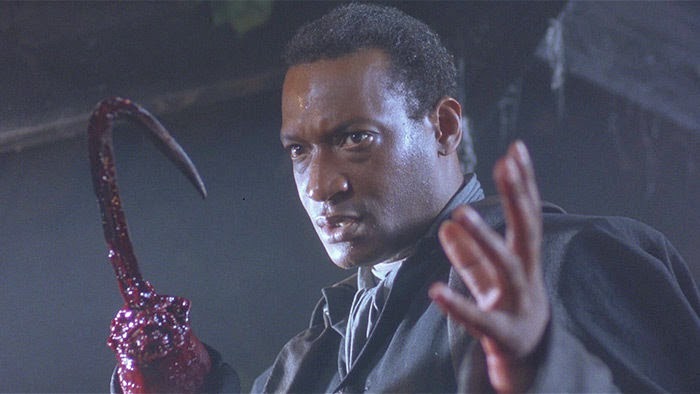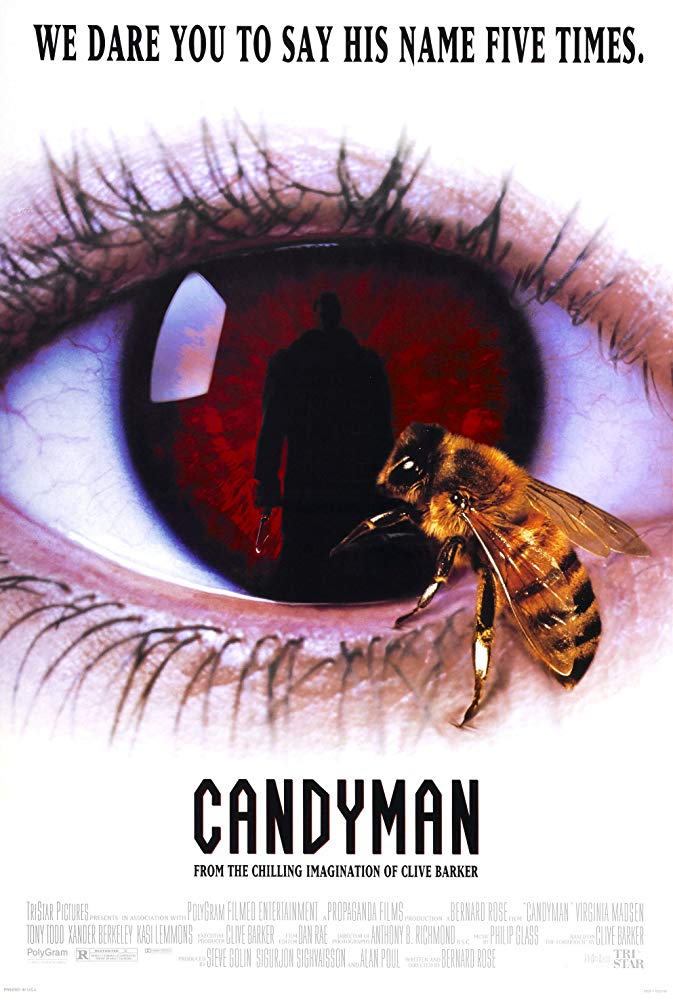
CANDYMAN ***** USA 1992 Dir: Bernard Rose. 92 mins
“Your death would be a parable to frighten children with”. The opening story of the fifth volume of “Books of Blood”, Clive Barker’s “The Forbidden” was a bleakly evocative story of urban folklore in a miserabilist vision of a Thatcher-era Liverpudlian housing estate. Bernard Rose’s popular film adaptation, effectively shifting the story to modern-day gang-controlled Cabrini Green in Chicago, sustains a similar sense of pervasive dread. Establishing the mythology of its imposing – yet undeniably erotic – boogeyman via an opening distillation of modern American slasher films featuring Ted Raimi and a bathroom mirror jolt, Rose’s film isn’t above cheap jump scares, some of which play like studio-requested embellishments. It gives us a smart, courageous heroine (Virginia Madsen) – on a beguiling quest to understand the reasoning behind an entire community attributing the horrors of their daily lives to a mythical figure. Summoned via the chanting of his name five times into a mirror (an echo of the popular “Bloody Mary” urban legend), Candyman himself (Tony Todd) is represented mostly off-camera for the first 45 minutes, his presence conveyed via abstract images, exposition-spouting characters, clever misdirection and a sonorous voiceover.
Todd embodies one of the genre’s most striking villains, his mellifluous vocal presence established at the very beginning as he turns the most gruesome of violent threats into something elegant and seductive (“What’s blood for if not for shedding…”). His first appearance at the half-way mark is a startlingly unexpected encounter with Madsen in a well-lit multi-storey car park, where her first emotional reaction is for a tear to roll down her cheek. On-screen only intermittently, Todd haunts the entire film, with Rose’s adaptation borrowing many lines from the original story, heightening the parallels to classically romantic genre monsters (notably Dracula) as Candyman promises immortality via “just one exquisite kiss…” Ultimately the story of an unhappily married, cuckolded woman who escapes into a fantastical existence with a bold, dangerous lover, CANDYMAN is a dynamic scary movie on first watch thanks to a succession of visceral set pieces and a marvellously sour punchline. Repeat viewings, however, highlight the subtleties in performance from both Madsen and Todd, alongside the beguiling fairy tale eroticism of their union – all enhanced by the oppressive choral score composed by Philip Glass, itself a remarkable work of portentous beauty.
CANDYMAN: FAREWELL TO THE FLESH *** USA 1995 Dir: Bill Condon. 93 mins
Michael Culkin’s “Basil Exposition”-style British scholar from CANDYMAN is the traditional ill-fated returning-character in this sequel, perishing after foolishly staging a Candyman “appearance” as a lark on his book tour. With this scene, the film begins as it means to go on: a slick follow-up largely content to live up to the lazy promises of its awful trailer (“The terror in the mirror returns!”) while forgetting to comprehend that Philip Glass’ remarkable music only truly works if accompanied by the elegiac, perversely seductive mood of Bernard Rose’s original. Part two switches locations to Candyman’s birthplace, New Orleans during Mardi Gras, with school teacher Kelly Rowan doing the mirror “thing” to prove a point to her kids: Candyman returns via appearances that are perfunctory rather than mesmerising, with the sexual chemistry of the original’s central duo notably absent and Rowan prone to whimpering during dramatic moments.
Tony Todd is reduced to delivering weakly recycled variations of his original monologues. The sequel gets bogged down with endless fake scares accompanied by loud musical stings and featuring birds, husbands, etc. appearing out of nowhere for the sake of a contrived “jump”. Director Condon still keeps things lively, and it’s the goriest CANDYMAN movie, as bees crawl out of open wounds, Timothy Carhart is eviscerated as Rowan looks on and a gruesome flashback to Candyman’s demise caps an unfolding backstory about Rowan’s family history. The early digital FX (including an shattering-Candyman effect at the climax) are predictably aged, though the script is the worst offender, right up to its contrived “shock” ending.
CANDYMAN: DAY OF THE DEAD * USA 1999 Dir: Turi Meyer. 85 mins
 Artisan’s depressingly mundane coffin-nail for the CANDYMAN franchise relocates the action to the Hispanic quarter of Los Angeles during the eponymous festival, where artist Donna D’Errico tries to convince herself that rumours surrounding Candyman (her great, great grandfather) are just the stuff of legend by…saying his name five times into a mirror. In a characteristically lame retread of the original, D’Errico then gets the blame for the killings of various disposable characters when you-know-who (Tony Todd, also co-producing) shows up.
Artisan’s depressingly mundane coffin-nail for the CANDYMAN franchise relocates the action to the Hispanic quarter of Los Angeles during the eponymous festival, where artist Donna D’Errico tries to convince herself that rumours surrounding Candyman (her great, great grandfather) are just the stuff of legend by…saying his name five times into a mirror. In a characteristically lame retread of the original, D’Errico then gets the blame for the killings of various disposable characters when you-know-who (Tony Todd, also co-producing) shows up.
A totally generic sequel from the director of the CANDYMAN-influenced SLEEPSTALKER, this loses the haunting elegance of Philip Glass’ music and reduces Todd’s magnetic, entrancing “monster” to the level of a routine slasher villain. D’Errico, clad mostly in small tops and prone to screaming excessively at every available opportunity, provides the unsympathetic heroine the script deserves, while Nick Corri confirms Hollywood’s enduring fondness for stereotypes by essentially reprising his role of Latino-falsely-suspected-of-killings-and-persecuted-by-the-cops from the original NIGHTMARE ON ELM STREET! Numerous dumb false scares (the terrified cries of D’Errico’s flatmate turn out to be her practising for a role she has won in a horror movie) alternate with cliched, telegraphed “shocks” and the shameless cash-grab is confirmed by lowest-common-denominator shtick including a topless girl covered with bees.
CANDYMAN **** USA 2021 Dir: Nia DaCosta. 91 mins
 In two lazy sequels to Bernard Rose’s iconic 1992 CANDYMAN, Tony Todd’s extraordinary presence was wasted, the concept cheapened by lame jump scares in FAREWELL TO THE FLESH and taken into slapdash slasher territory for DAY OF THE DEAD. Todd and Clive Barker’s original short story “The Forbidden” now have a truly worthy 21st century successor in the form of co-writer / director Nia DaCosta’s 2021 CANDYMAN. With the creative input of producer Jordan Peele, DaCosta sets the tone by introducing a rather different “Candyman” than the one we might be expecting: a 1970s Cabrini Green outcast with a hook for a hand and a (rumoured) tendency to menace kids with razor-lined confectionery.
In two lazy sequels to Bernard Rose’s iconic 1992 CANDYMAN, Tony Todd’s extraordinary presence was wasted, the concept cheapened by lame jump scares in FAREWELL TO THE FLESH and taken into slapdash slasher territory for DAY OF THE DEAD. Todd and Clive Barker’s original short story “The Forbidden” now have a truly worthy 21st century successor in the form of co-writer / director Nia DaCosta’s 2021 CANDYMAN. With the creative input of producer Jordan Peele, DaCosta sets the tone by introducing a rather different “Candyman” than the one we might be expecting: a 1970s Cabrini Green outcast with a hook for a hand and a (rumoured) tendency to menace kids with razor-lined confectionery.
Exposition related to the original film is beautifully conveyed via shadow puppetry – and by a familiar voiceover later on. Virginia Madsen’s 1992 heroine Helen Lyle is now the one whispered about in classrooms, someone who snapped and committed the murders we attributed to “Candyman”. The stuff of urban legend. Cabrini Green as we knew it has gone. The housing created by white people for disenfranchised black people ended up creating a dangerous ghetto and was demolished in between films. Its gentrified 2021 incarnation, however, is haunted by the legacy of Helen and “Candyman”. Tortured artist Yahya Abdul-Mateen II becomes obsessed with the subject, just as Helen did, but this time, she is a key part of his research and his ultimate connection to past events becomes a very personal one that also revives a character from the Rose movie.
CANDYMAN 2021 delivers chills and gore, but not in the way we might expect from a contemporary Hollywood horror. The expected kills are often cleverly captured in aftermath or via reflections, or just out of sight. A spectacularly visualised gallery slaughter paves the way for creatively realised set pieces – with a prep school bathroom massacre conveyed via glimpses of mayhem in a dropped compact mirror, while a bullied black girl cowers in a toilet, ‘BLM’ patch visible on her bag. DaCosta excels at sustaining an ambience of grave unease, channeling Cronenbergian body horror as the story tracks the gruesome impact of a bee sting.
The strongest element of this smart, reverential sequel only becomes apparent in the final act, when one of modern horror’s most evocative stories becomes a film about the importance of storytelling itself. Ultimately, Nia DaCosta’s CANDYMAN isn’t just about Tony Todd’s established “Candyman” / Daniel Robitaille. It’s about generations of the persecuted, the disenfranchised, the fallen black men who need to be remembered for any kind of progress to be made. The devastating last line of the film confirms this need for telling the tales, for whispering in classrooms about real and fictional “Candyman” figures. For Rodney King, severely beaten by the L.A.P.D. in March 1991. For George Floyd, killed by a police officer in Minneapolis in May 2020, a month before this film’s originally intended theatrical release. For (tragically but inevitably) more as yet unknown black men to come.
Reviews by Steven West


